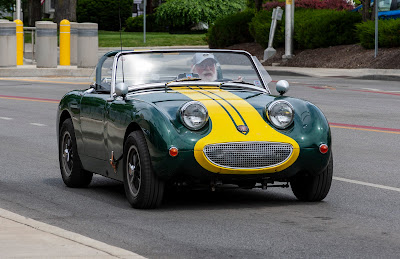You'd need a heart of stone to resist the adorable good looks of a first-generation Austin-Healey Sprite.
The classic "Bugeye" front end is because the headlights were supposed to lie flush when turned off and rotate up into position when turned on, like the later Porsche 928. In a fit of parsimony, however, BMC decided that would cost too much money and so the twee little car looks like a perpetually happy frog.
And when I say "twee little", I'm not kidding. Not quite eleven and a half feet long, riding on an 80-inch wheelbase, the Bugeye Sprite turned up on our shores in 1959, weighing in at 1477 pounds all gassed up and ready to go. This was a time when a typical Detroit sedan, say a Chevy Impala, cast a shadow nearly eighteen feet long and pressed down on the scales with two tons of iron.
The flyweight little sports car was propelled by a version of BMC's little inline four displacing 58 cubic inches (that's 948cc's, so smaller than a lot of modern motorcycle engines.)
Because British cars were taxed via an arcane formula that placed a penalty on piston area, the BMC A-series 4-cylinder was an undersquare long-stroke tractor motor, with a sub-2.5 inch bore and a 3-inch stroke. To liven it up, Austin-Healey fitted an intake sporting two SU 1-bbl carburettors, bumping the power to 43bhp, up from the thirty-odd you'd find in more pedestrian Austin or Morris compact saloons.
The luggage rack on this gorgeous '59 Bugeye is no affectation. The whole rear of the body forms a monocoque, which was a novelty in the late Fifties. To avoid weakening this structure, there's no trunk lid cut into it. If you want to fetch anything out of the rear storage cubby, your spare tire for instance, you needed to fold the seatbacks forward and go spelunking.
Like most car nerds of my age, my first exposure to the wonders of the Bugeye Sprite was via the writings of Peter Egan on the pages of Road & Track.
"The first sports car I ever drove on a race circuit was an H-Production Bugeye Sprite, which I bought in 1973. To be competitive with other SCCA production cars of that era, the Bugeye needed beefier, lowered springs, a big front sway bar, thicker shock oil, Ferodo DS-11 brake linings, better rear axles, a Panhard bar, a locked differential, wider wheels, better tires, an oil cooler and a heavily modified engine. All in order to get around the track with any kind of regularity. Even then, the Sprite broke something or blew up about every 20 minutes.
Despite all these chassis modifications (or maybe because of them), my Bugeye didn't really handle all that well—mostly because I was either too stupid or cheap to put on a heavier front anti-sway bar than the spindly aftermarket device that came with the car. If you got the back end loose in any sudden maneuver, it had a tendency to snap-spin. Like, right now. The car just wanted to go backward. It was a hairy little crate to drive. Also, the spring rates were chosen on the "any suspension will work if you don't let it" theory, based on a long tradition of English coal cart technology. A minor road seam could knock all your fillings out."



